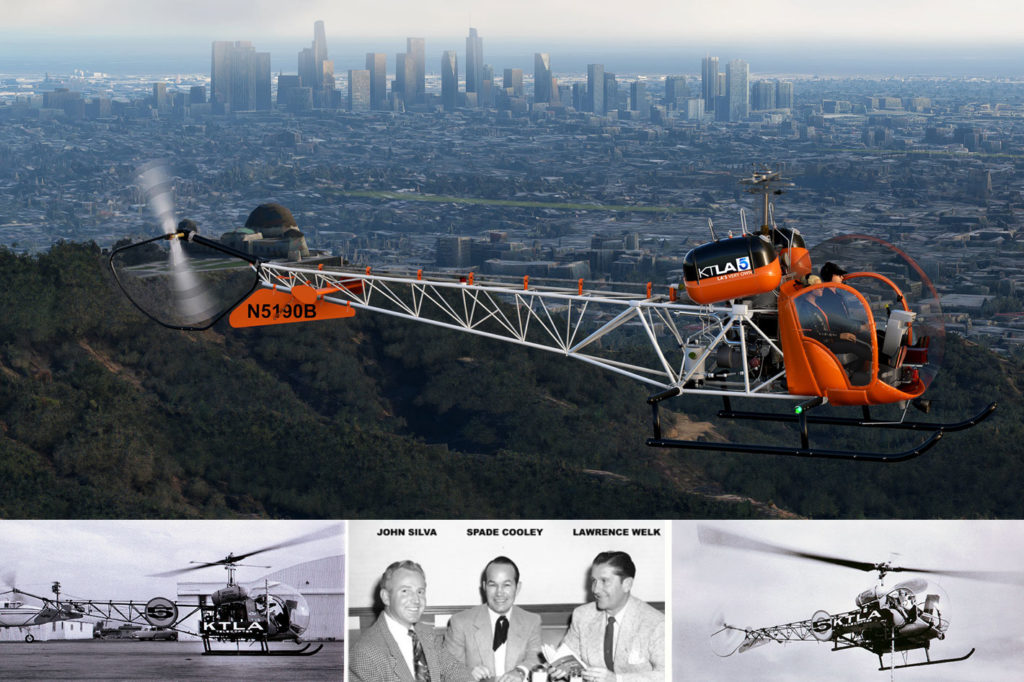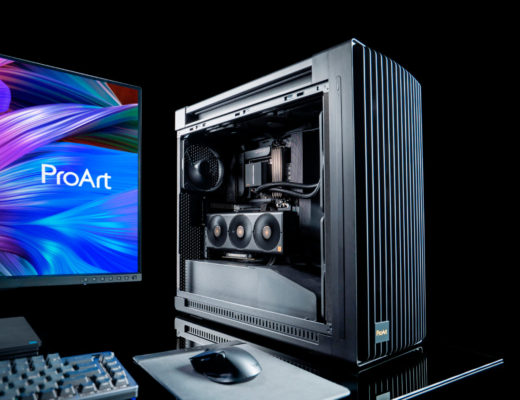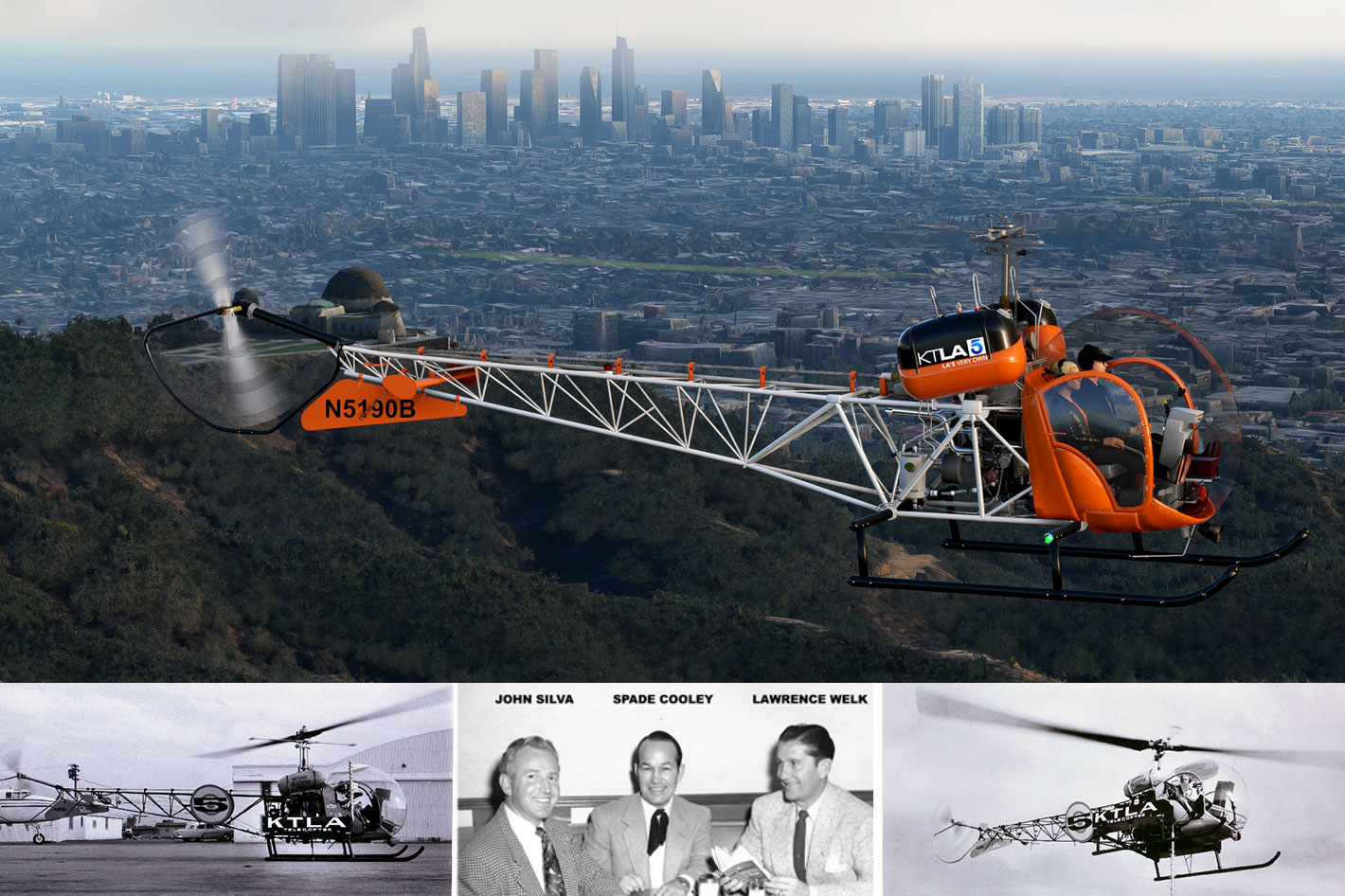 On July 4, 1958, when the first images from the hand-held camera onboard the helicopter were received by the engineers on the ground, news gathering changed forever. The KTLA-TV Telecopter was born.
On July 4, 1958, when the first images from the hand-held camera onboard the helicopter were received by the engineers on the ground, news gathering changed forever. The KTLA-TV Telecopter was born.
Helicopter news footage is so common today that we don’t think how complex the whole process is: imagine sending live pictures from a fast-moving aerial platform to a TV station on the ground, so they are shared, in real-time, with audiences. We’re so used to take the bird’s eye view for granted when we watch images of forest fires, traffic accidents or police pursuing a car that we forget the laborious process behind it. All that was made possible in 1958, when John D. Silva, who was the chief engineer of KTLA-TV in Los Angeles, invented the Telecopter, a helicopter outfitted with a live TV camera.
It was not an easy process. At KTLA one of John D. Silva major tasks was to make sure the mobile units were designed physically and electronically for maximum speed of operation in getting to “on-the-spot” breaking news events quickly and getting on the air before the competition did. “This was quite a challenge, to say the least”, the engineer wrote, in his book about the invention of the world’s first mobile news unit in a helicopter.
The Los Angeles area is not just extremely huge it was already at the time, as John D. Silva wrote in his book, a “humanity-crowded territory filled with vehicular traffic and all kinds of other forms of congestion” including many geographical obstacles and many locations that were non-line-of-sight situations to Mount Wilson, “where we were not able get microwave signals out from ground level.”
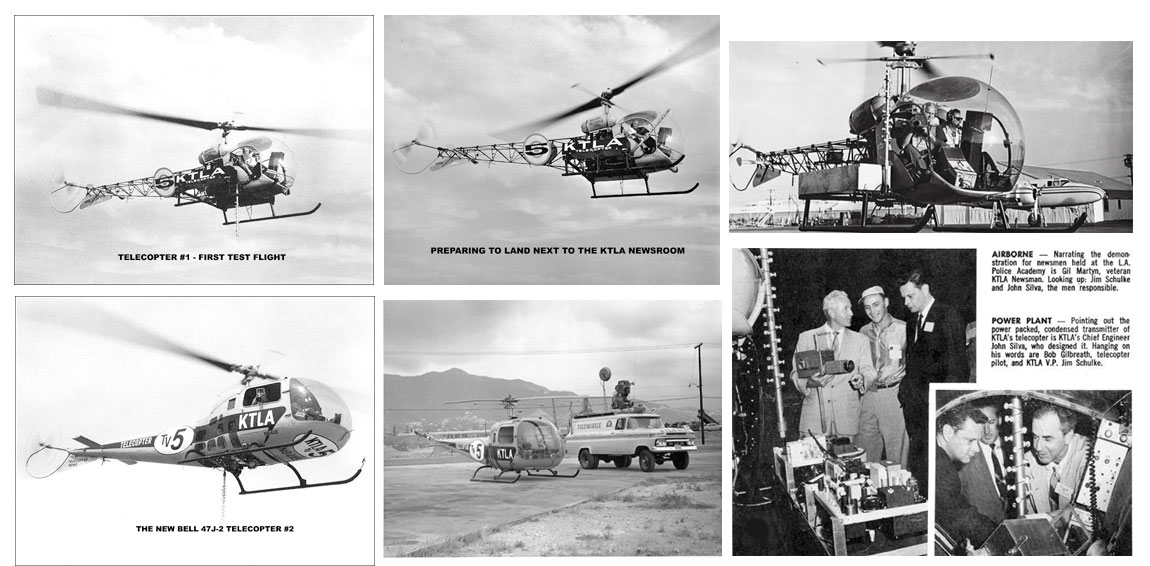 The Telecopter idea was born on a Hollywood freeway
The Telecopter idea was born on a Hollywood freeway
The idea of building a news mobile unit in a helicopter crossed Silva’s mind while he was driving to work one morning on the Hollywood freeway. If that was possible, KTLA would avoid missing out on news events at times because of traffic tie-ups delaying the arrival at a location, and it would allow the station to beat the competition. After studying the project, John D. Silva felt sure the design and construction of a Telecopter was feasible, but the idea was met with some resistance from the company at the time, so it took a while – and a new general manager, Jim Schulke – for the project to go ahead.
Kept as a secret that only a few people knew about, the Telecopter project evolved as John D. Silva found a way to get the 2000 pounds of needed equipment and cable (power generator, camera, microwave transmitter, antenna, video support equipment, audio, control equipment and inter-connecting cables) down to 368 pounds, which was a strict Federal Air Administration (FAA) requirement.
Then it was time to choose the helicopter to use and after researching, Silva opted to use the National Helicopter Service, a local company, based at Van Nuys airport, that suggested the Bell 47G-2 as the ideal platform for the very first flying TV studio. The Bell 47 is an iconic single-rotor single-engine light helicopter with more than 5,600 units produced, including those under license by Agusta in Italy, Kawasaki Heavy Industries in Japan, and Westland Aircraft in the United Kingdom. Designated H-13 Sioux by the US Army, it served a variety of roles, including reconnaissance and scouting, search and rescue, and medevac during the Korean war.
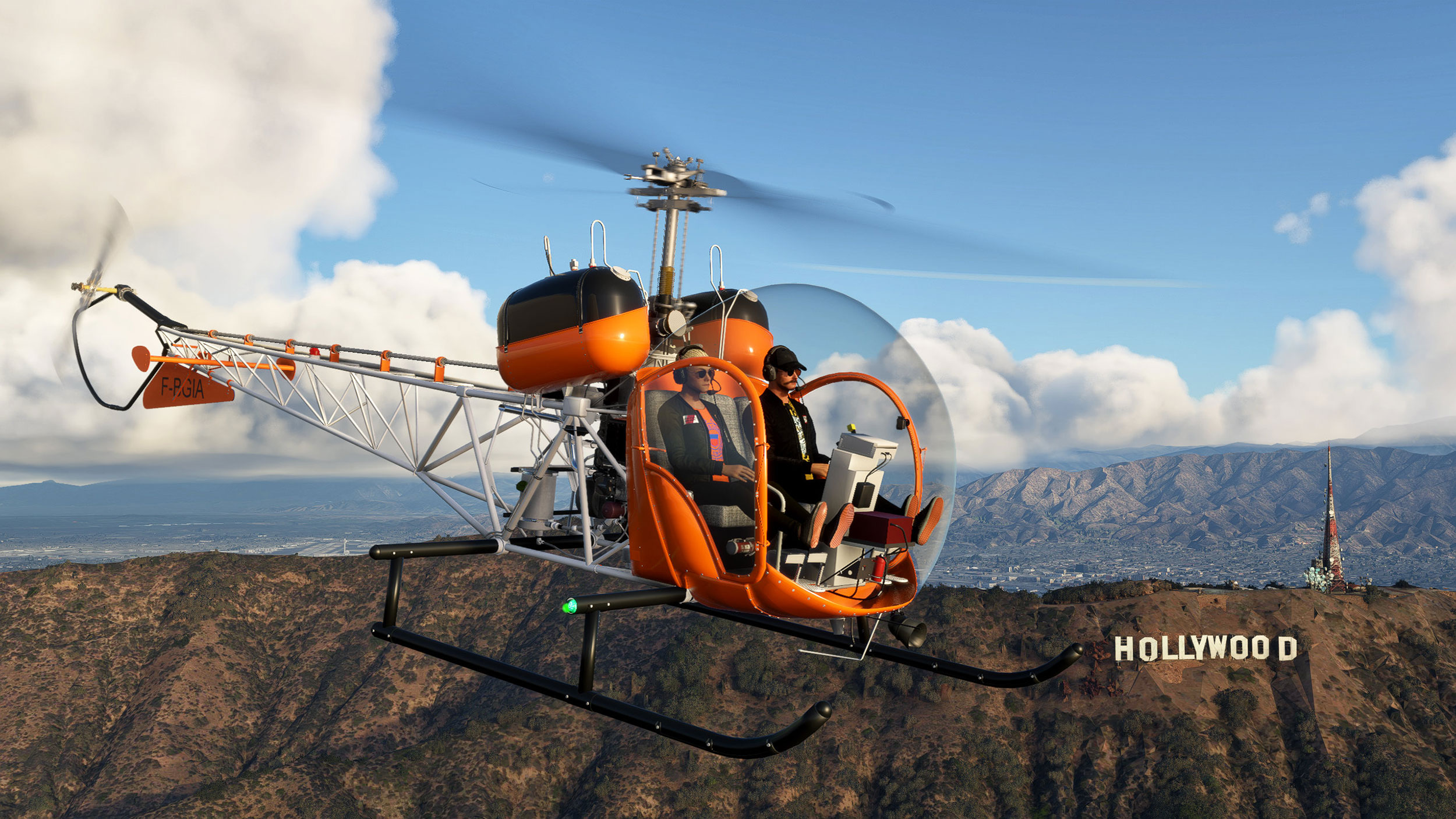 Bell 47: an extremely popular helicopter
Bell 47: an extremely popular helicopter
The Bell 47 became the first helicopter certified for civilian use on 8 March 1946 and the helicopter used by NASA during the Apollo program, used by astronauts as trainers for the lunar lander. The Bell 47 was also the first helicopter to fly over the Alps and set an altitude record of 18,550 feet (5,650 m), besides having set a world distance record for piston helicopters of 1,217 miles (1,959 km) by flying nonstop from Hurst, Texas, to Buffalo, New York, a record that still stands today. An executive version of the original Bell 47, the Bell 47J Ranger, was the first helicopter to carry a United States president.
The helicopter is also popular in Hollywood movies and television series, starting in the 1950s, when the television series Whirlybirds, produced by Desilu Studios, starred a pair of Bell 47 helicopters. The same model was also used for the Australian television series Skippy the Bush Kangaroo. From Frederico Fellini’s La Dolce Vita to the 1965 James Bond film Thunderball or the 1966 Batman film, Bell 47 helicopters have been used. One of the most popular Bell helicopters, though, is the military configuration as a H-13 Sioux, which was central to the 1970 film M*A*S*H, as well as the 1972–1983 M*A*S*H television series based on it.
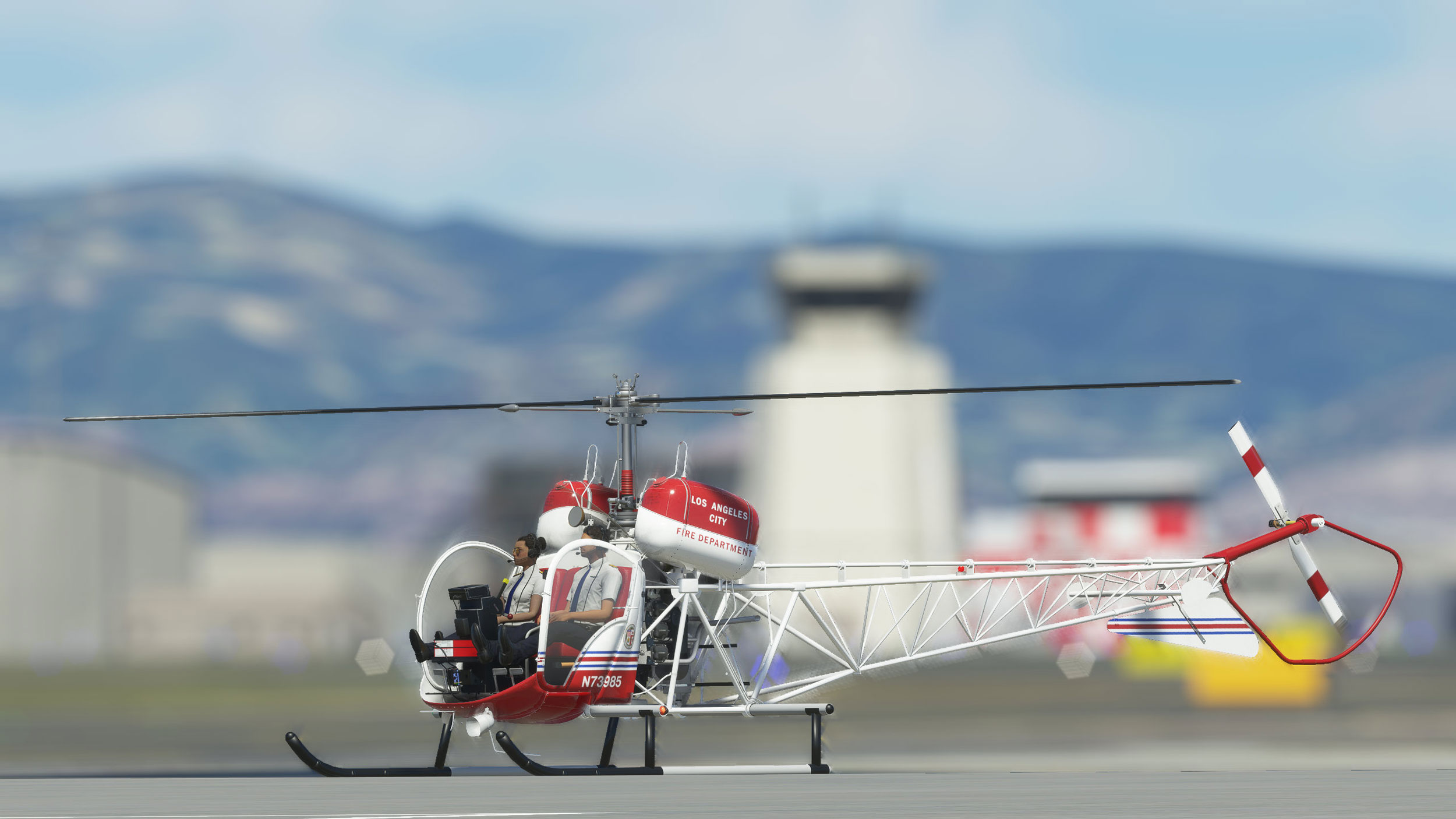
The Bell 47G-2 helicopter I just bought
So, the Bell 47 helicopter has been popular both in front and on the other side of the camera. Which leads me to the reason why I followed this story: I recently bought a Bell 47G-2 helicopter. No, not a real helicopter – although it is still available for sale – but a version made for Microsoft Flight Simulator. Created by FlyInside, the Bell 47G-2 is the ideal platform to explore the world representation created inside the simulator, which Microsoft brought back to life last year.
As usual, when I buy an aircraft to use in any flight simulation, I do it because I’ve some interest into its history and performance. With the Bell 47G-2 I wanted the flying characteristics of a real helicopter, as much as they are possible to recreate inside a computer simulation, but I was also curious about its history, beyond the M*A*S*H series connection I was aware of. It was then that I found, among other interesting information, the association with the invention of the Telecopter by John D. Silva, a story that really deserves to become a movie. I wonder if anyone has thought about this before.
If you need any reason to believe this Telecopter story was an adventure, the revelation that on the first flight John D. Silva had to climb, without a safety belt, onto one of the helicopter’s landing skid while it hovered at 1,500 feet (457 m), so he could investigate why there was no image being broadcasted, should suffice. But the whole project was an adventure itself, one that changed the world of news forever.
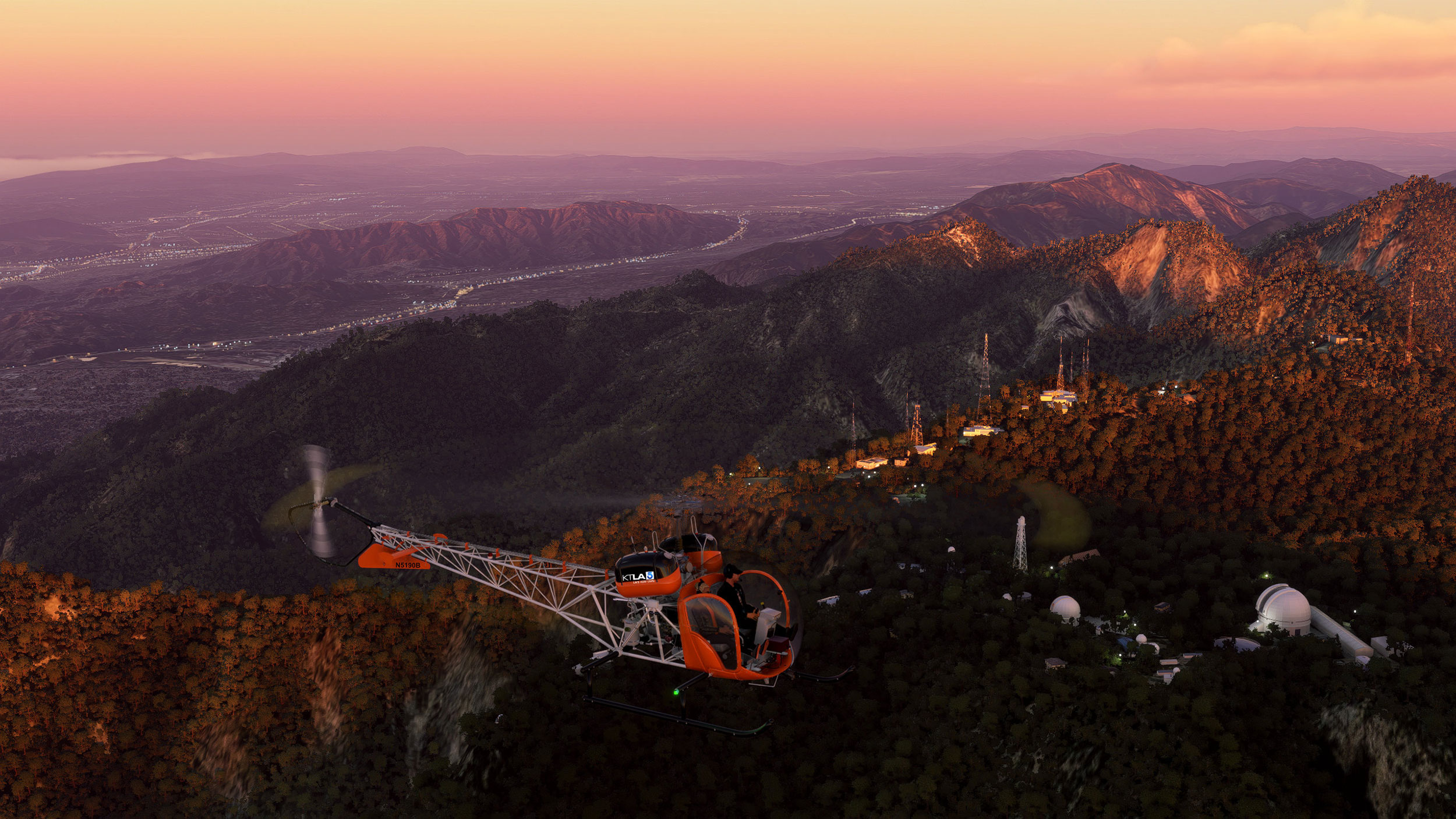
Mount Wilson, a natural barrier
The Telecopter project was kept secret, and only a few people at KTLA knew what the team was building in a backyard, somewhere in the Los Angeles area. The first flight was on July 3, 1958, when, as John D. Silva writes in his book, “with Larry Scheer as pilot, and I as engineer/cameraman, took off for our first test flight at the Van Nuys Airport” only to discover, he adds, that “…we weren’t able to get our microwave signals through to the receiver on Mt. Wilson.” That’s the moment when Silva stepped out of the cockpit to check what was wrong: he discovered that a vacuum tube had failed due to the intense summer heat, noise, and vibration from the helicopter’s engine and main rotor.
The problem was fixed overnight and the Telecopter was ready for a new test flight on July 4, 1958, when Larry Scheer and John D. Silva took off from Van Nuys Airport. When the camera was pointed at some Hollywood houses, engineers at Mt. Wilson reported that they were receiving picture and sound from the hand-held camera. The signals weren’t perfect, but they were good enough to confirm that the Telecopter was viable.
The Telecopter also solved a problem KTLA had for a long time: the difficulty created by covering news from the ground in locations that were non-line-of-sight situations to Mount Wilson, where the pioneer station had erected the first television antenna in 1947. In fact, Mount Wilson, a peak in the San Gabriel Mountains, in the Los Angeles area, is easily identifiable due to the large number of antennas near its summit, used for relay broadcasting of radio and television for the Greater Los Angeles Area. The area is also the location of the Mount Wilson Observatory, which is an important astronomical facility in Southern California.
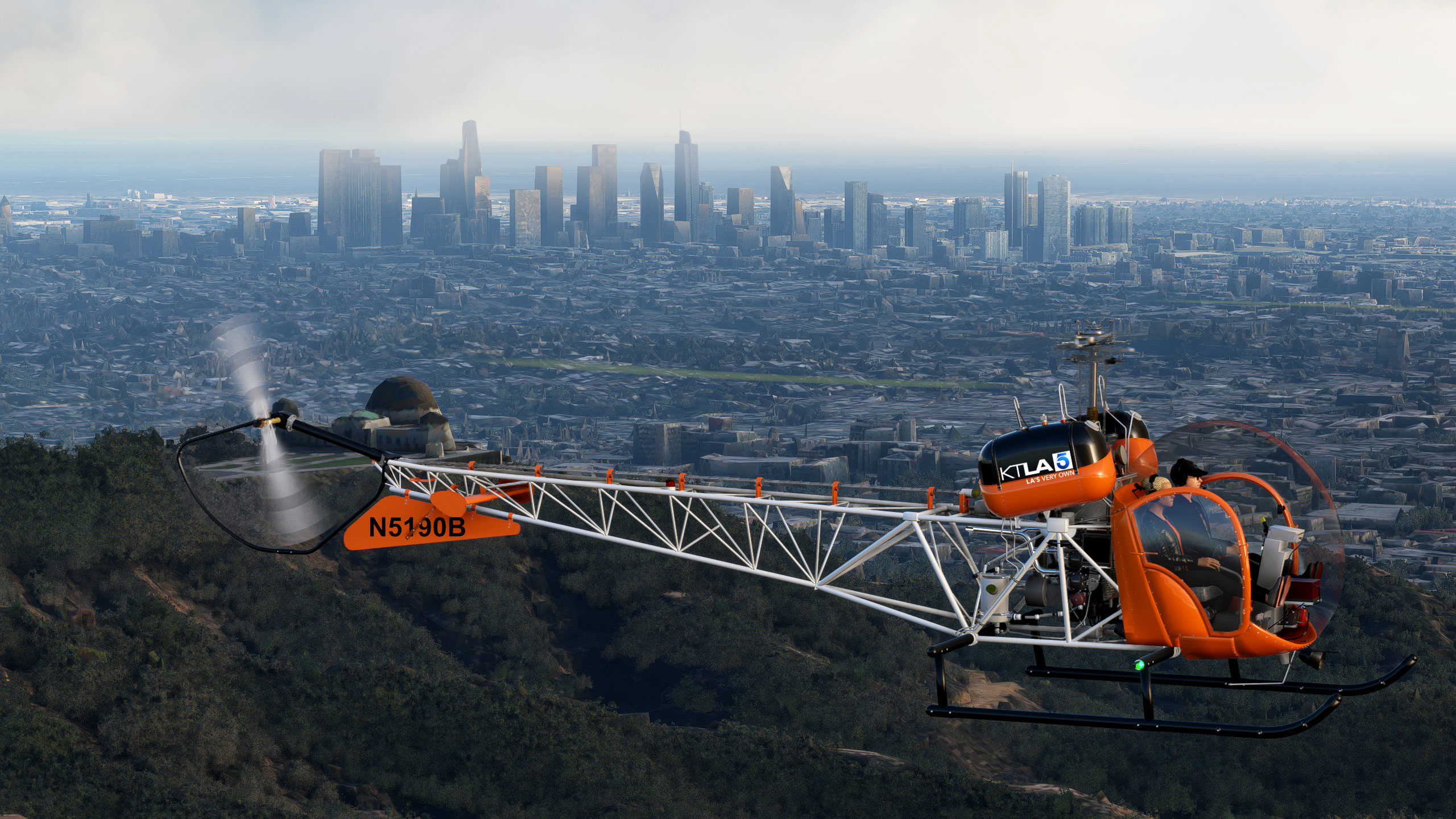
The Telecopter and Telemobile
Although it took a bit longer, in 1963, John D. Silva decided to make the Telecopter – then the more modern Bell 47J-2 – work with the new mobile units the KTLA station had acquired. He called the unit Telemobile and configured it to simultaneously transmit both pictures and sound up to a dedicated microwave receiver in the Telecopter, which could then relay them to the station at Mount Wilson, from where they were sent to the KTLA studio in Los Angeles. The solution allowed KTLA to originate live news events from the ground units from locations that had been completely inaccessible before.
The first non-public demonstration of the Telecopter in action took place on July 24, 1958 at the Police Academy. With Bob Gilbreath, vice-president of the National Helicopter Service company as pilot and John D. Silva as cameraman, the Telecopter flew over the freeway inter-exchange and above the Los Angeles City Hall, transmitting images and sound directly to Mount Wilson and from there to the receiver at the Los Angeles Police Academy, where Fire, Police, Sheriff Officials, and members of the press were watched with great interest on the two 27-inch TV monitors.
The first public demonstration of the Telecopter took place on July 29, 1958, when KTLA television audiences had a chance to see how the station would be using the Telecopter for on-the-spot breaking news in the very near future. On September 15, 1958 KTLA commenced the world’s first daily airborne news coverage with the Telecopter in a Bell 47G-2 helicopter. Aerial coverage of news was about to change forever…
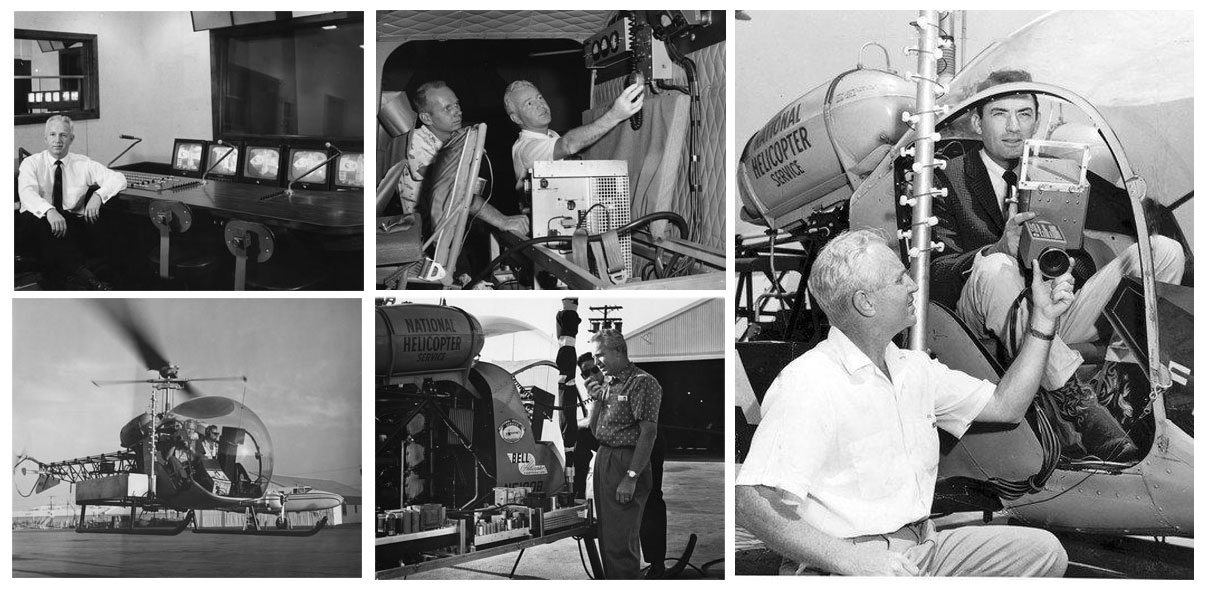 Being ahead of the competition
Being ahead of the competition
To read more about the Telecopter story, the best source is the website Tech-Notes, which has a long article under the title Engineering Activity at KTLA Over The Years written by John D. Silva, available in pdf format, from where I picked some of the images used in this article. It’s the key source for much of the information you’ll find elsewhere about the Telecopter project but is also excellent reading about the life experience of the engineer and the part he played in the development of television. Excellent reading that you should download and explore.
John Daniel Silva was born in San Diego on February 20, 1920, and died in Camarillo, California on November 27, 2012, at the age of 92. He was KTLA’s chief engineer for 21 years and director of engineering research from 1976 until 1978, when he retired to become an electronics design consultant. When asked, by Air & Space magazine in a 2009 interview about his pioneering project he replied, “I never thought about being a pioneer, all I ever wanted to do was get us there and get the picture — before the competition got it.”
If you want to know more, the Television Academy Foundation has a treasure trove to explore: three-and-a-half-hour interview with John D. Silva where he talks about his early interest in television and his desire to get into engineering.
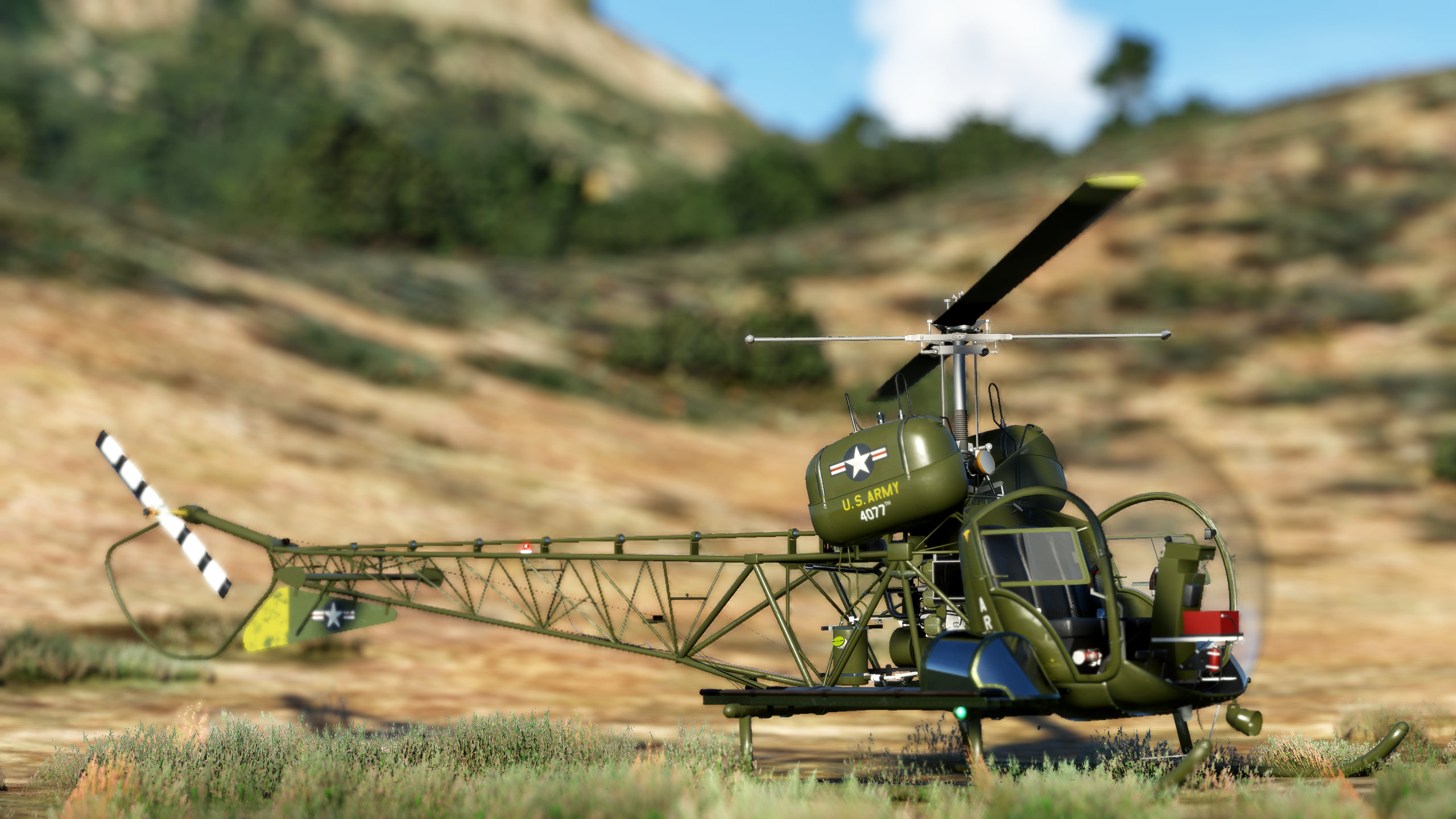 From the Telecopter to M*A*S*H
From the Telecopter to M*A*S*H
So, this whole story started when I acquired a Bell 47G-2 for Microsoft Flight Simulator. That’s when the Telecopter project became a subject I wanted to read about… and write about, as we celebrate 63 years since its first flight. I even tried to get someone to create a livery similar to the original helicopter from KTLA-TV, but not being able to get it done, I used Affinity Photo to place the KTLA logo on my version of the Bell 47G-2 flying against a popular background: the Los Angeles skyscrapers.
Because the open architecture of Microsoft Flight Simulator allows for third party and other user content to be added, I was able to add elements that help to build a slice of reality into a simulation, which is one of the great things of being able to mix work and fun. At flightsim.to, a website dedicated to free-addons for the simulation, I found a Hollywood sign that looks better than the one in the base sim. I also found an incredible representation of Mount Wilson, with the observatory and cluster of antennas, so if I want to recreate some of the first Telecopter flights I can check the key points of the story.
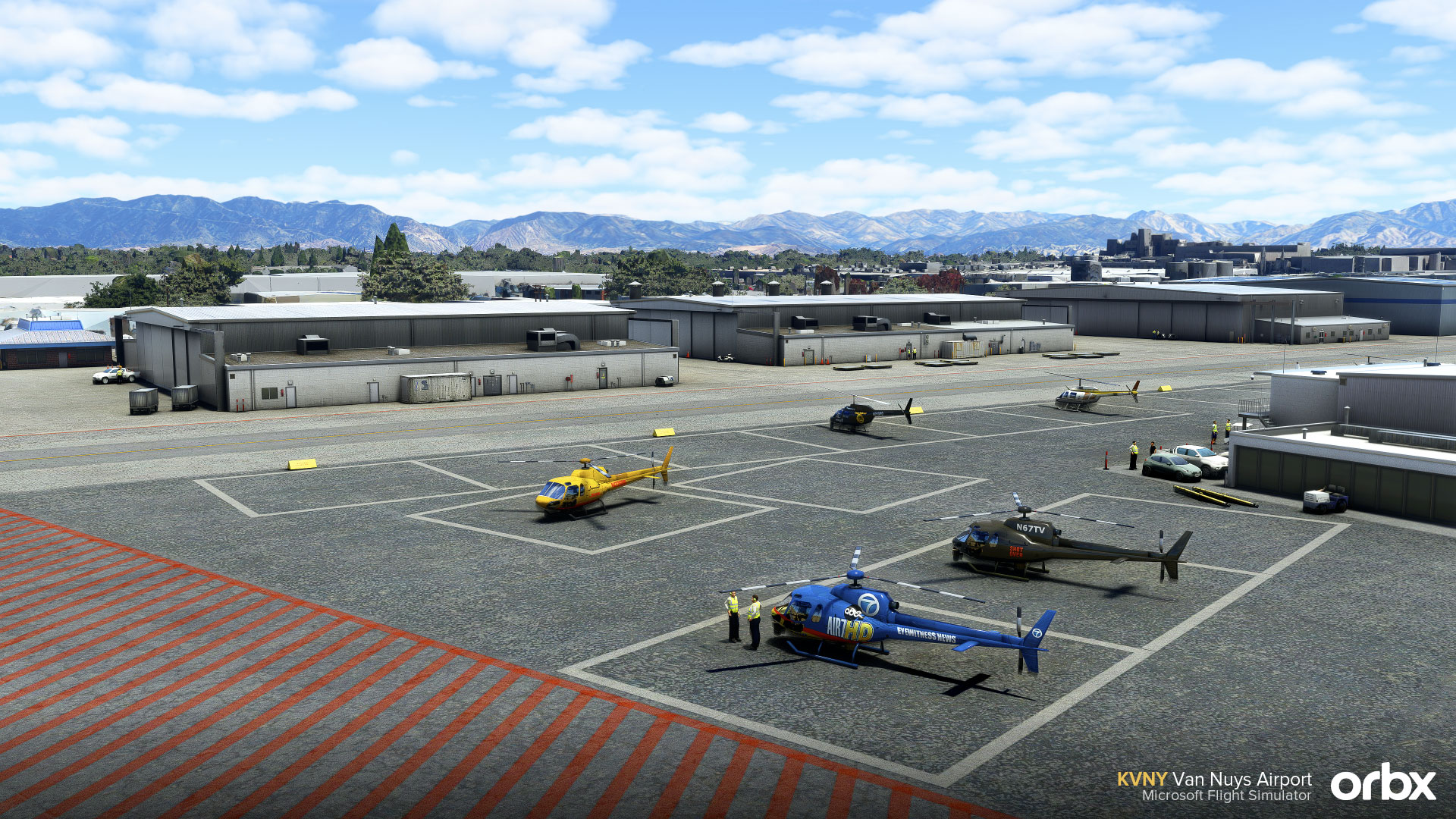
Van Nuys Airport (KVNY), which is also an element of the story, is now available in an exceptionally good add-on from Orbx. The largest and busiest general aviation airport in the world, with about 230,000 aircraft movements annually, it was built in 1928 as a place for dreamers and pioneering pilots to try out their new flying machines… as the Telecopter. KVNY is often used for television, music and film videos. One example: parts of the climatic scene of the film Casablanca (1942) were filmed at Van Nuys Airport, at the time known as Metropolitan Airport.
Because Van Nuys is also the base for the Los Angeles City Fire Department, it was easy to find a livery for the Bell 47, which is shown in this article in one image with the control tower at Van Nuys as background. Because this is also one article about television, I found a livery for the helicopter that recreates the M*A*S*H TV series. There are now two M*A*S*H liveries available and a third being made by FlyInside, who created the Bell for the simulation. After having the helicopters painted, people also wanted to have the original filming site, so someone explored after the location and… found it inside Microsoft Flight Simulator.
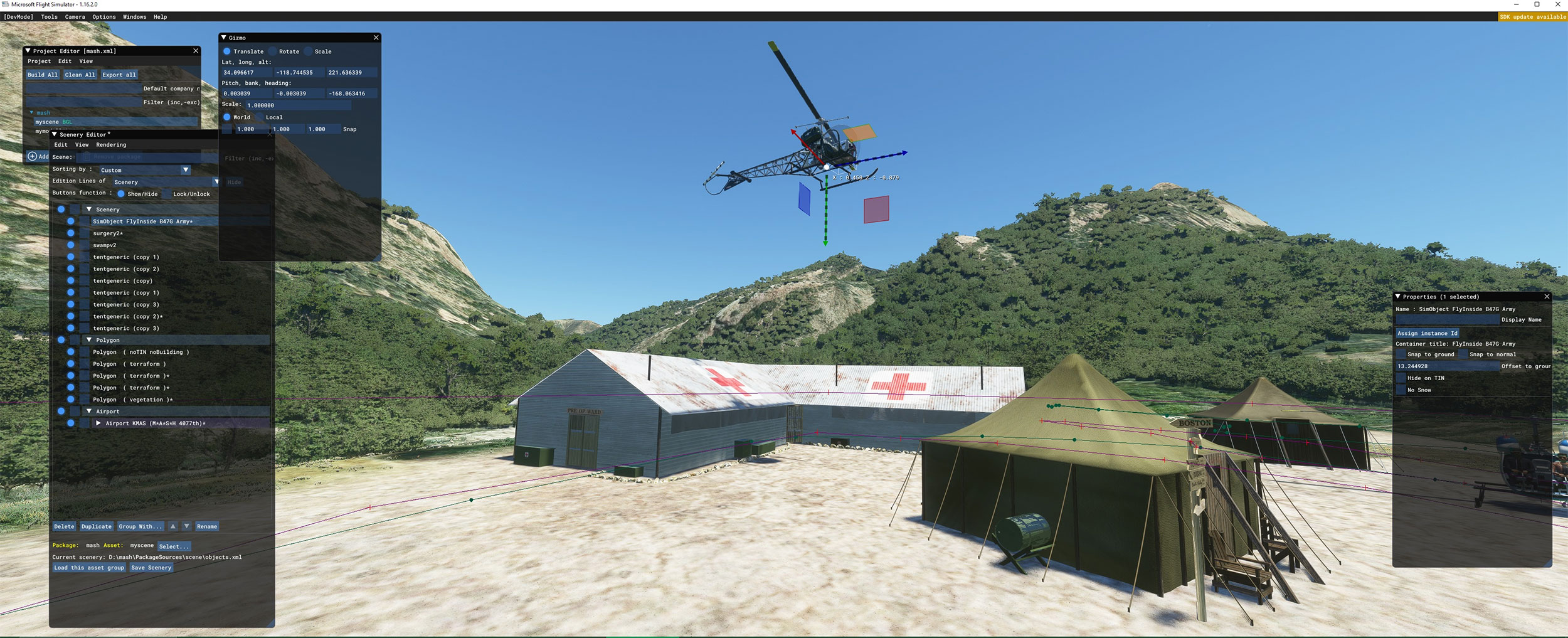 Believe me, there is someone recreating the M*A*S*H camp site in Microsoft Flight Simulator, and it’s coming along rather nice, as the image published here shows. When it’s ready, we will see a flock of Bell 47G-2 virtual pilots with the M*A*S*H livery on their machines fly there, after downloading the add-on. Some will even create cinematic narratives of their journey. It’s a good example of how things work both ways with flight simulation: thanks to a virtual representation of a helicopter, I found the whole story about the Telecopter which I may have missed otherwise, while others are discovering or rediscovering a film and TV series thanks to a Bell 47 with a M*A*S*H livery.
Believe me, there is someone recreating the M*A*S*H camp site in Microsoft Flight Simulator, and it’s coming along rather nice, as the image published here shows. When it’s ready, we will see a flock of Bell 47G-2 virtual pilots with the M*A*S*H livery on their machines fly there, after downloading the add-on. Some will even create cinematic narratives of their journey. It’s a good example of how things work both ways with flight simulation: thanks to a virtual representation of a helicopter, I found the whole story about the Telecopter which I may have missed otherwise, while others are discovering or rediscovering a film and TV series thanks to a Bell 47 with a M*A*S*H livery.
One final note: as Microsoft Flight Simulator can be explored with a VR headset, we’re talking about total immersion when you enter the cockpit of the Bell 47G-2 and fly to the different locations around Los Angeles, recreating the experience of the first Telecopter, or when you land at the M*A*S*H camp site that is being recreated inside the sim.

Filmtools
Filmmakers go-to destination for pre-production, production & post production equipment!
Shop Now